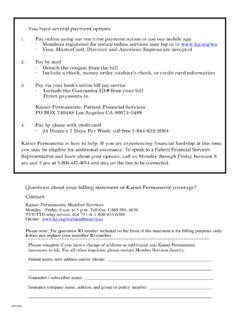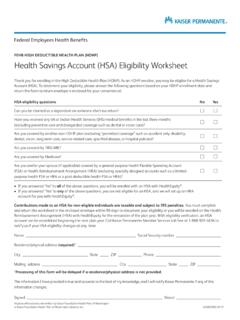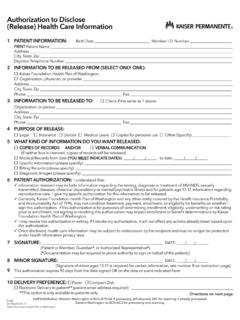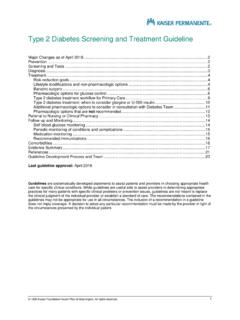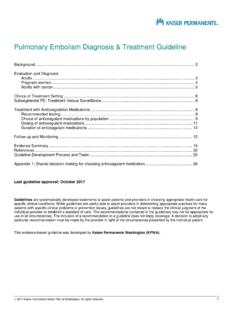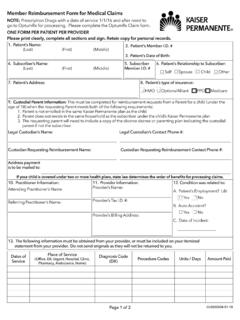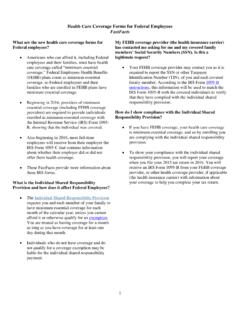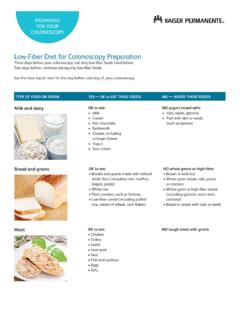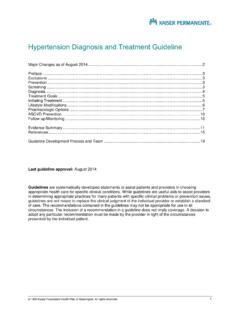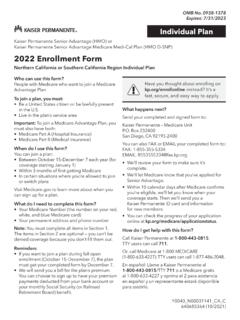Transcription of Migraine and Tension Headache Guideline - Kaiser …
1 Migraine and Tension Headache Guideline Major Changes as of May 2021 .. 2. Medications Not Recommended for Headache Treatment .. 2. Background .. 2. Diagnosis Red flag warning signs .. 3. Differential diagnosis .. 3. Imaging .. 3. Migraine versus Tension Headache .. 4. Medication overuse Headache .. 4. Menstruation-related Migraine .. 4. Tension Headache Acute treatment .. 5. Prophylaxis .. 5. Migraine Headache Acute treatment .. 7. Treatment of refractory Migraine .. 8. Prophylaxis: overview, guiding principles .. 9. Prophylaxis options: self-care, monitoring .. 9. Prophylaxis options: complementary/alternative 10. Prophylaxis options: supplements .. 11. Prophylaxis options: medications and procedures .. 12. Menstruation-related Migraine 15. Medication Overuse Headache Treatment .. 16. Evidence Summary .. 17. References.
2 21. Clinician Lead and Guideline Development .. 22. Last Guideline approval: May 2021. Guidelines are systematically developed statements to assist patients and providers in choosing appropriate health care for specific clinical conditions. While guidelines are useful aids to assist providers in determining appropriate practices for many patients with specific clinical problems or prevention issues, guidelines are not meant to replace the clinical judgment of the individual provider or establish a standard of care. The recommendations contained in the guidelines may not be appropriate for use in all circumstances. The inclusion of a recommendation in a Guideline does not imply coverage. A decision to adopt any particular recommendation must be made by the provider in light of the circumstances presented by the individual patient.
3 This evidence-based Guideline was developed by Kaiser permanente Washington (KPWA). 2018 Kaiser Foundation Health Plan of Washington. All rights reserved. 1. Major Changes as of May 2021. Melatonin, zinc, and vitamin D may be considered for Migraine prophylaxis. Butterbur and coenzyme Q10 are no longer recommended for Migraine prophylaxis. Additional complementary and alternative therapies may be considered for preventing both Tension and Migraine headaches, including biofeedback, cognitive behavioral therapy, relaxation training, mindfulness, and yoga. Occipital nerve block may be used as an adjunct treatment to reduce the frequency and intensity of Migraine headaches. Botulinum toxin or anti-calcitonin gene-related peptide (CGRP) monoclonal antibodies may be given to reduce the frequency and intensity of Migraine headaches.
4 Administration of these treatments is limited to Neurology providers. Adequate trial of at least three other formulary preferred prophylactic Migraine medications and documentation of no medication overuse Headache may be required for health plan coverage. Medications That Are Not Recommended KP Washington and national Headache guidelines advise against the use of opioids and butalbital-containing medications ( , Fiorinal, Floricet) for treatment of headaches. Print out and share or encourage your patients to view the Choosing Wisely guide on the low value and risks of using opiates for Headache : KPWA advises against the use of estrogen-containing oral contraceptive pills for Migraine with aura due to increased risk for stroke. There is insufficient evidence to support the use of SSRIs, venlafaxine, gabapentin, or coenzyme Q10 for Migraine prophylaxis.
5 Butterbur is no longer recommended for Migraine prophylaxis because it may contain a compound that is hepatotoxic and carcinogenic. Background This Guideline includes diagnosis and treatment of the most common Headache types that are managed in Primary Care: Tension Headache Migraine Headache , including menstrual Migraine Medication overuse Headache (also known as rebound Headache ). Cluster headaches are excluded from this Guideline because of their low prevalence in the general population and the severity of the symptoms. For patients with suspected cluster headaches, consider consulting with Neurology for evaluation and treatment. Populations excluded from this Guideline include pregnant individuals and children aged 13 years and younger. Note: KPWA and national guidelines advise against the use of opioids and butalbital-containing medications ( , Fiorinal, Fioricet) for treatment of headaches.
6 2. Diagnosis Red flag warning signs For patients with a rapidly accelerating course, a recent history of head injury, or focal neurologic findings, consult with a neurologist or neurosurgeon. Use the SNOOP mnemonic to identify red flag warning signs requiring immediate or urgent evaluation: Systemic Conditions: malignancy, HIV, pregnancy Signs: fevers, sweats, rash, weight loss Neurologic Symptoms: any neurologic symptoms other than classic aura (such as confusion or double vision). Signs: optic nerve edema, abnormal neurologic exam Onset sudden (< 5 minutes). Older than 50 years Pattern change Change in type or quality of Headache More than 50% increase in frequency or severity Consider using the Patient Questionnaire for Headaches to evaluate patients for red flags. When patients have no red flags or indications for imaging, ask them to gather more data on their headaches and schedule follow-up in Primary Care in 1 to 2 weeks to assess their response to empiric treatment.
7 The SmartPhrase .AVSHEADACHEDIARY and the handout Your Headache Log provide patients instructions for keeping a Headache log and advice about when to seek immediate medical attention. Differential diagnosis Consider the following can't miss Headache causes at least once in your evaluation of a new-onset Headache or a change in an existing Headache pattern. Create a concrete differential diagnosis to rule out can't miss causes of Headache using the DATA C2A2N save lives mnemonic from David Newman-Toker, MD: Dissection (carotid or vertebral). Arteritis (giant cell). Thrombosis (dural venous). Aneurysm (leak, expansion, or subarachnoid hemorrhage). Carbon monoxide, Colloid cyst Angle closure glaucoma, Angina Norepi neoplasm (pheochromocytoma). Imaging Order imaging only when your differential diagnosis supports it. Imaging should not be done solely for reassurance.
8 High- end imaging (CT or MRI) for uncomplicated Headache increases costs, radiation (CT), and anxiety for patients without improving quality of care. Most urgent causes of Headache are not ruled out with a non-contrast head CT and need to be excluded with specific imaging, exam, or serologic testing. A head CT does not clear a patient with Headache . 3. Migraine versus Tension Headache Source: International Headache Society 2018. Table 1. Distinguishing between Migraine and Tension -type Headache Migraine Headache Tension Headache 4 72 hours' duration. 30 minutes' to 7 days' duration. Aura may be present. No aura. At least two of the following bullets are true: At least two of the following bullets are true: Unilateral location. Bilateral location. 1 1. Moderate to severe pain intensity. Mild to moderate pain intensity. Pain described as pulsating.
9 Pain described as pressing or tightening (not pulsating). Aggravated by routine activity. Not aggravated by routine activity. At least one of the following two bullets is true: Both of the following bullets are true: Sensitivity to light and/or sound is present. No sensitivity to light or sound, or sensitivity to only one of the two. Nausea and/or vomiting is present. Neither nausea nor vomiting is present. 1. Pain intensity Mild: Patient is aware of Headache , but able to continue daily routine with minimum alterations. Moderate: Headache inhibits daily activities, but is not incapacitating. Severe: Headache is incapacitating. Medication overuse Headache (MOH). Source: International Headache Society 2018. Medication overuse Headache (MOH; also known as rebound Headache ) is Headache occurring at least 15 days per month in patients with pre-existing primary Headache who have regularly overused acute or symptomatic Headache medication for 3 months or longer.
10 ( Overuse is defined as > 10 days or > 15 days per month, depending on the medication.) It usually, but not invariably, resolves after the overuse is stopped. A common culprit is over-the-counter medications, which are not always on the medication list. It is important to rule out MOH prior to initiating therapy for any acute Headache . See MOH Treatment, p. 16. Menstruation-related Migraine Source: International Headache Society 2018. Episodes of Migraine without aura (as defined in Table 1) occurring in the window of 2 days before to 3 days after menstruation, in at least two out of three menstrual cycles. 4. Tension Headache Acute treatment of Tension Headache Note: It is important to rule out medication overuse Headache (MOH) prior to initiating therapy for any acute Headache . See MOH Treatment, p. 16. Table 2. Pharmacologic options for acute treatment of Tension Headache NOT RECOMMENDED.
